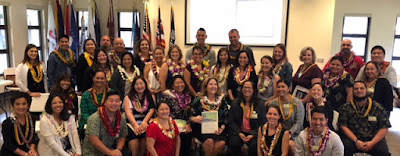Crushing It as a Leader
Sandy Cameli, EdD • Educational Specialist • Hawaii Dept. of Education
Recently, colleagues and I shared resources, networking opportunities and impactful takeaways gained from attending a national conference. I proudly announced that I was inspired by - and now have a professional crush on - Simon Sinek (@simonsinek). The proclamation was met by raised eyebrows, snickers and humorous comments. Somewhat red-in-the-face, I tried to further clarify my statement by saying, “No, this isn’t that same puppy-dog infatuation we all experienced in middle school, rather I’m drawn to his intellect, motivation and ability to create visual messages - don’t you just want to crawl inside his head and hang out there for awhile?” After what seemed like an uncomfortably-long, cricket-worthy pause, a rushed reconfiguration of discussion to the next topic emerged, and I let it go … or at least for the time being.
On the drive home I pondered - Why would the term “professional crush” elicit such a response? Isn’t it possible to admire a role model’s intelligence without tying emotions to a heart-beating, palm-sweaty obsession? It certainly did not imply a demotion of an individual’s credibility, or lack of respect for the professional, but rather a heightened awareness of finding someone who gets equally excited about new learnings, amazing opportunities and passion projects! So how then do we capitalize on the synergy, savviness and social-connectivity of inspirational role models, while also encouraging others to enjoy the “high” often accompanied by interacting with these like-minded rockstars?
By unpacking the topic I was able to identify qualities, traits and characteristics of professional crushes who have mesmerized, inspired or left me wanting more from their thinking, actions and energy. And, in an attempt to reintroduce the concept of a Professional CRUSH to my peers - through a more palatable format - the following descriptors were identified:
C = challenges self, stakeholders or the status quo to exceed potential
R = recognizes the importance of seeking alternative paths to problem solving
U = understands the “power of we” by advocating for multiple perspectives
S = shares untested ideas and unknown possibilities to promote risk-taking
H = humbly, yet earnestly, puts the “goal before the role” as a leader
R = recognizes the importance of seeking alternative paths to problem solving
U = understands the “power of we” by advocating for multiple perspectives
S = shares untested ideas and unknown possibilities to promote risk-taking
H = humbly, yet earnestly, puts the “goal before the role” as a leader
Effective leaders can leverage strengths from any Professional CRUSH by asking these questions: When was the last time I challenged my thinking about a system, structure, ritual or routine, in order to enhance the work we’re doing? What lens should I use to recognize alternatives to problem solving? How do I engage and invite peers to better understand multiple perspectives? Who can I share design thinking models with in order to encourage risk-taking by others? Do I exhibit enough humility and transparency in my daily practice to inspire colleagues to lead too?
After identifying these elements, I next reflected upon how a leader’s message could resonate so strongly for me (or any lifelong learner for that matter), that a professional crush could be formed. Was it the message, the delivery, the environment or the content? Sure, all of those factors played a role in my reaction, but the bottom-line was I felt a connection to another individual - whom I had never met - yet, I knew I could instantly befriend and spend hours aligning our work (should the planets align!) Here was someone who shared my values, beliefs, goals and aspirations; a fellow-earthling who laughed at similar humor, possessed an insatiable appetite for learning, and who made the rest of us mortals feel as if we too could fly!
So, while giggles may persist and eye-rolls become the norm when the term “professional crush” is raised, I believe it’s important to pursue opportunities and seek out those individuals who elevate our interest and generate enthusiasm for the amazing work we do in the field of Education. And, if this manifests itself into my heart skipping a beat, mild dizziness occurring, or endless prattle about an inspirational speaker with stars in my eyes - I’m willing to suffer the side effects!
Shout-out to a #ProfessionalCrush
My list continually grows! Share yours too!
| @BreneBrown | Dr. Nikki Woodson |
| @brightmorningtm | @MichelleObama |
| @dintersmith | @pasi_sahlberg |
| @DrDebbieSilver | @rubyKpayne |
| @jenniferabrams | @simonsinek |
| @JBerckemeyer | @SirKenRobinson |
| @Malala | @YongZhaoEd |
(Transparency Disclaimer: This is not to say I still wouldn’t















